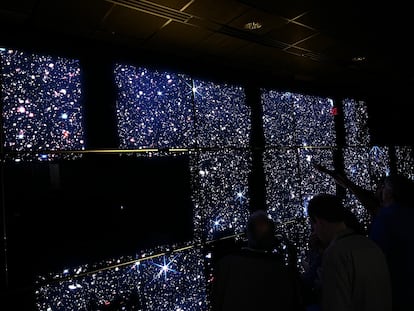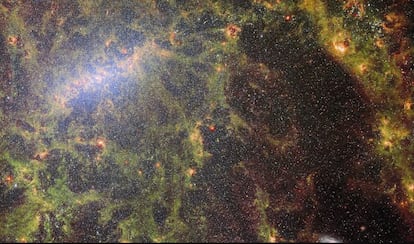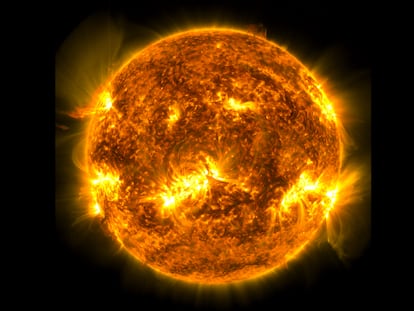What do photographs of New York’s orange sky have in common with the search for (more) distant galaxies?
From a physical perspective, two of the James Webb Space Telescope’s most unexpected results are related to recent images of New York

One of the James Webb Space Telescope’s (JWST) most important goals is to discover and closely study distant galaxies, including the first ones that formed in the universe. How do we approach this work? What are the difficulties? What have we learned in this first year of JWST’s work on this topic? From a physical perspective, the answers are related to the images we recently saw of a Blade Runner-like (or Mars-like) New York. Allow us to explain.
The first thing those of us who are into this primordial galaxy stuff do is, essentially, look for a needle in a haystack. Basically, we want to identify a few dozen galaxies that are candidates to be at a great distance from the tens of thousands of new galaxies (meaning, galaxies that nobody knew about before) that appear in images captured by JWST.
Much of the data that JWST has gathered are images through which we want to discover new galaxies and simultaneously calculate their distances. The methods for determining these distances by using images are not very precise and sometimes they fail miserably; nevertheless, they are the only methods that can be applied to data that aim to study tens, or hundreds, of thousands of new galaxies. The method is based on analyzing what we know as galaxy colors.

What is the color of a galaxy (or anything)? Simply put, the dictionary tells us that color is the “sensation produced by the luminous rays that make an impression on visual organs and that depends on the wavelength.” Words fall short because the distant galaxies we “see” with JWST are detected by photons at mid-infrared wavelengths, which start in the range used by our TV remote controls and end up where most of their energy is emitted by some infrared heaters (such as those in soccer stadiums) or by our bodies (in the absence of any illumination). None of this radiation is detectable by the human eye, which only sees wavelengths equivalent to the well-known rainbow. But in physics we talk about something’s color to compare whether it emits more or less energy at one wavelength than another.
If an object emits more energy in one area of the spectrum with a longer wavelength than another, it is said to be red; if the opposite is true, it would be blue. If it emits the same amount, it is gray. That’s how we construct the beautiful images that appear in informative articles like this one. To measure these colors, we take images in several areas of the spectrum using different filters or bands that only let a part of the photons through. For example, JWST observes in bands around a wavelength of 2 microns (of micrometers, with rainbow light having a wavelength of around 0.5 microns), another at 2.8, another at 5.6, and so on up to about 30 bands covered with various instruments.
In broad brushstrokes, a distant galaxy must be apparently red if we compare the light that reaches us from it in the visible zone — the one our eyes see —or near-infrared —as seen by telescopes like Hubble — with the mid-infrared, the one remote controls and JWST see. The main reason is because the emission from the galaxy’s stars is redshifted by the effect of the universe’s expansion. So, in the end, distant galaxies are extremely red (infinitely red if we choose the bands well) when we compare filters around 2.0-2.8 microns with bluer filters (1.15 or 1.50 microns).
We detect photons from distant galaxies that tell us what they were like at the time they were emitted, so we are actually seeing what the universe was like at its origins
By measuring not just one color but several (about 10), we determine what we know as the redshift, a parameter we refer to with the letter z. The higher the redshift, the greater the distance to the galaxy. The distances are so great that light from distant galaxies has taken almost as long as the universe’s age to reach us. Thus, when we detect those photons, they tell us what that galaxy was like at the time it emitted them, so we are actually seeing what the universe was like at its origins (and we don’t know what it is like now).
We are reaching beyond z∼10 with JWST; that does not seem very high (the Big Bang would be at the infinite limit, which we would write as z→∞) but it’s equivalent to a universe age of about 500 million years, less than 4% of its present age. During the first three weeks of normal JWST science operations, two galaxies were discovered (out of about 10,000) whose colors indicated that they were at redshifts greater than z∼10, more specifically, z∼11 and z∼16. They were discovered by several research teams working independently on the same data. And they all agreed on their redshift results. We did not expect to find such distant galaxies in the mission’s first year; we believed we had to take data for several years to get that far. In other words, we were seeing galaxies that were too bright for the distance we thought they were. The discovery was so early and unexpected that we even gave the galaxies special names. We called the z∼11 one Maisie’s Galaxy, after the daughter of the first author of the paper in which we presented the discovery (scientists wear their hearts on their sleeves). The other one was called Schrödinger’s Galaxy, for a more physical reason that we explain below.

The problem is that a galaxy does not just appear red in images — like those taken by JWST — because of its distance, and there are many types of “red.” There are other ways to make a galaxy red, one of which is based on the same reason that explains why we saw those recent images of New York.
When a medium has a lot of dust — defined as particles of carbon, silicon, hydrogen and other elements, about one micron in size — in it, the light that passes through does not do so homogeneously. We could say that the trajectory of blue photons is deflected in all directions; they are said to be scattered. In contrast, red photons pass through the medium more easily, and they are ultimately the ones that reach our eyes. In general, many photons of all types are eaten by dust, but especially blue photons. That explains why we saw a dark orange New York recently, when the particles from the Canadian wildfires arrived there. It also explains the beautiful sunsets in Spain when dust from the Sahara invades the country.
Some galaxies harbor a lot of dust created in a great pyre, such as the formation of new stars. All the big galaxies that we see around us have surely had a moment when it was better to mop up; in fact, we are the result of that metaphorical mop, which brought the dust together for millions of years, giving rise to planets and life. If a galaxy has dust, we see it as red. The problem for those of us who study primordial galaxies is that we can confuse a very distant galaxy that is red because of its distance with a closer galaxy that has a lot of dust.
How do we distinguish a nearby red galaxy with dust from a very distant red galaxy? Well, JWST also provides a solution; it is the observatory’s greatest strength. The JWST gathers another type of data, which is not image data but spectroscopic data. The latter data offer much more information, although they are far more difficult to obtain and require much more observation time. That is why we must pre-select interesting objects to do what is called spectroscopic monitoring.
Some galaxies harbor a lot of dust, particles of carbon, silicon, hydrogen and other elements, during the formation of new stars. We are the result of how dust came together over millions of years, giving rise to planets and life
The spectroscopic monitoring of Maisie and Schrödinger, led by a Spaniard (working outside Spain), indicated that the former galaxy was indeed very distant, z∼11, while the latter was a closer dusty galaxy, at z∼5. Those values translate to universe ages of 500 and 1.2 billion years, respectively. They don’t seem very different, but they are, if only in terms of the known universe’s size; the former is twice as large, at z∼5, as the latter, at z∼11. In fact, there were some hints that the Schrödinger galaxy could not be z∼16, but all the analyses (except one, I must say proudly but sadly, because z∼16 would have been tremendous) indicated a higher likelihood of that possibility than the dusty alternative. Only with new data — ”opening the box to see the cat” — did we learn the Schrödinger galaxy’s true nature.
Having discussed how we discover distant galaxies and the challenges of doing this work, we’ll end here by asking: what have we learned about the universe’s formation in JWST’s first year of operation? Well, beyond how we should use JWST, we’ve learned two unexpected and closely related things. First, the universe was able to form galaxies faster than we thought; we didn’t think galaxies like Maisie should exist, it’s too bright for how far away it is. The second is that what might seem like a failure — we thought that Schrödinger was the most distant galaxy ever observed — is actually another great result; in fact, it is the same result. Galaxies like Schrödinger have too much dust to be as distant as they are; the universe was able to form elements like carbon or silicon very quickly and turn it into dust very efficiently. That always makes me think that “carbon-based entities” could have been dancing around the cosmos for a very long time. From my very biased point of view, that’s all fascinating! We will continue to report on the findings.
Sign up for our weekly newsletter to get more English-language news coverage from EL PAÍS USA Edition
Tu suscripción se está usando en otro dispositivo
¿Quieres añadir otro usuario a tu suscripción?
Si continúas leyendo en este dispositivo, no se podrá leer en el otro.
FlechaTu suscripción se está usando en otro dispositivo y solo puedes acceder a EL PAÍS desde un dispositivo a la vez.
Si quieres compartir tu cuenta, cambia tu suscripción a la modalidad Premium, así podrás añadir otro usuario. Cada uno accederá con su propia cuenta de email, lo que os permitirá personalizar vuestra experiencia en EL PAÍS.
¿Tienes una suscripción de empresa? Accede aquí para contratar más cuentas.
En el caso de no saber quién está usando tu cuenta, te recomendamos cambiar tu contraseña aquí.
Si decides continuar compartiendo tu cuenta, este mensaje se mostrará en tu dispositivo y en el de la otra persona que está usando tu cuenta de forma indefinida, afectando a tu experiencia de lectura. Puedes consultar aquí los términos y condiciones de la suscripción digital.
More information
Archived In
Últimas noticias
Susan Boyle prepares a comeback just as Timothée Chalamet sings her praises
Trump suspends green card visa lottery after shooting at Brown University
When things get out of hand at the lab: Hundreds of accidents expose the ‘catastrophic’ risk of dangerous pathogen leaks
Venezuelan migrants contribute billions of dollars to Latin America, but continue to work in the informal sector
Most viewed
- Christian Louboutin: ‘Young people don’t want to be like their parents. And if their parents wear sneakers, they’re going to look for something else’
- Cartels in Mexico take a leap forward with narco-drones: ‘It is criminal groups that are leading the innovation race’
- Liset Menéndez de la Prida, neuroscientist: ‘It’s not normal to constantly seek pleasure; it’s important to be bored, to be calm’
- ‘El Limones’ and the growing union disguise of Mexican organized crime
- The low-cost creative revolution: How technology is making art accessible to everyone











































